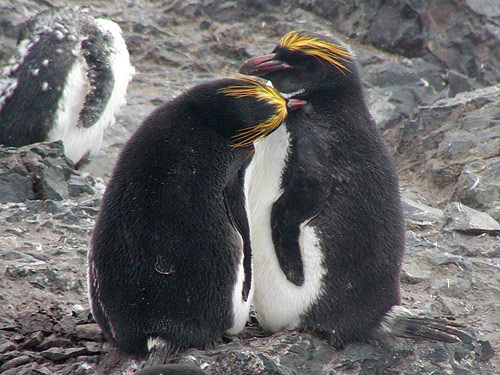The secret life of penguins
Scientists have long wondered what these non-feathered birds do for months on the sea as they prepare for breeding.

A research team from the National Center for Scientific Research (CNSR) attached monitoring devices to the foot of a dozen empty and female macaroni penguins (scientific name Eudyptes chrysolophus ) at winter beginning at pants. Kerguelen island in the Indian Ocean.
Birds swim out to sea a few days later during the annual feeding season and tracking devices record the location, frequency of light and water temperature wherever they come. The following spring, about six months later, the bird returned to Kerguelen beginning the breeding season. Scientists collected the devices and took blood samples to know what birds had eaten in the past half year.
Scientists determined that after leaving Kerguelen, the birds swam quickly to the east, south of the Indian Ocean, spread out over a large area, spending 80% of their time in a geographic area stretching from 47-49 latitudes. male level. The rest of the time they swim further south, near the Antarctic, but not near the ice tip. They swam a surprisingly long distance, averaging 10,430km in six months at sea. The most adventurous bird swims 2,400km from Kerguelen. In the last weeks of the migration season, they swim home like in a race, completing 1,743km of road in just one month.
Blood tests show that penguin's main food when living on the sea is crustaceans, not the mollusks in the region as extreme as ever speculated. This study is important due to the identification of the main feeding area of this bird, thereby helping conservation efforts.
- The secret of penguins
- The secret of not freezing of Antarctic penguins
- The pair of gay penguins adopted an egg after a long time to ... boulder incubation
- How do penguins differentiate?
- Mother penguins drop eggs, the whole herd rushes to the rescue
- The secret to keeping the penguin's warm
- Pair of gay penguins celebrating 10 years of living together
- Homosexual penguins 'kidnapping' penguin child to raise
- Penguins march in Hai Duong park, Japan
- A couple of penguins hold hands on the sea causing storms
- New Zealand built a tunnel for penguins
- Losing children, double crazy penguins kill the same kind
 Animal 'suffering' after hibernation
Animal 'suffering' after hibernation Why do goats climb well?
Why do goats climb well? Scientists were surprised to see chimpanzees eating turtles
Scientists were surprised to see chimpanzees eating turtles Giant catfish died deadly due to drought in Thailand
Giant catfish died deadly due to drought in Thailand Why can migratory birds fly thousands of kilometers without eating?
Why can migratory birds fly thousands of kilometers without eating?  When it rains, where do the birds take shelter?
When it rains, where do the birds take shelter?  100 years ago, a man released 60 strange birds, causing the US to lose $1 billion a year.
100 years ago, a man released 60 strange birds, causing the US to lose $1 billion a year.  Ancient Egyptian masterpiece so realistic that scientists accurately identified the birds in the painting
Ancient Egyptian masterpiece so realistic that scientists accurately identified the birds in the painting  Scientists plan to turn dead birds into drones
Scientists plan to turn dead birds into drones  Why did birds survive while dinosaurs became extinct?
Why did birds survive while dinosaurs became extinct? 